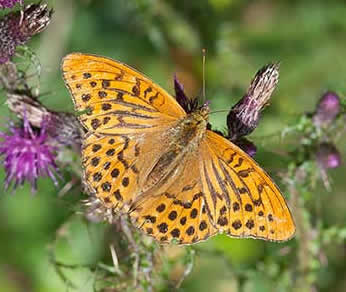Silver-washed Fritillary (Argynnis paphia)
When: Early July to mid-August
How many: Moderate numbers

The Silver-washed Fritillary is a stunning butterfly. Strikingly marked, it is the largest of the family to be found in Britain. Early entomologists were obviously, similarly impressed, for in the 18th century it was known as the Greater Silver-streaked Fritillary.
In the New Forest, Silver-washed Fritillaries are most often encountered within broad-leaved woodland inclosures from which commoners’ stock are wholly or largely excluded, allowing violets and brambles to flourish – these, respectively, are used as caterpillar food plants, and as a source of nectar for the adults.
Woodlands containing mature, well-spaced oaks are particularly favoured by Silver-washed Fritillaries, and ground-level vegetation should not shade out or smother the violets.
Silver-washed Fritillaries can be recognised fairly readily. Size is diagnostic, and so is their strong, swooping flight, an impressive sequence of graceful flaps and glides that carries them at speed over often considerable distances.
The background colour of the male Silver-washed Fritillary's upperwings is a deep, rich orange, whilst those of the female are a little darker. Both are generously marked with numerous black streaks and blotches. Underwings in both sexes are very similar: a prominent mixture of silver and pale green streaks on the hindwing, and on the forewing, darkish blotches against a subtle, pale-orange background.
Look out also for the silver-washed fritillary female form, Valezina, a variant that is quite widespread in the New Forest. Once quite appropriately known as Greenish Silver-washed Fritillaries, they have a greenish background colour to the upperwings, and are pink on the under forewing.
Indeed, these unusual insects so delighted the celebrated artist and naturalist F.W. Frohawk (1861-1946) that he named his daughter Valezina in their honour. (Frohawk was a regular visitor to the New Forest, so-much-so that deep in the woods south-east of Lyndhurst, he is commemorated by a woodland ride that carries his name).
Typically, Silver-washed Fritillary eggs are laid singly in a tree-trunk crack or crevice, or amongst moss, in semi-shaded woodland, but only after the butterfly has confirmed the availability nearby of the caterpillar food plants - preferably common dog-violets.
Eggs hatch within a few weeks, but the Silver-washed Fritillary larva immediately enter hibernation. Awaking in spring, they depend for life on quickly locating the violets.
References:
Butterflies of the British Isles: J.A. Thomas
The Butterflies of Hampshire: Matthew Oates, John Taverner, David Green et al
The Millennium Atlas of Butterflies in Britain and Ireland: Jim Asher, Martin Warren, Richard Fox, Paul Harding, Gail Jeffcoate and Stephen Jeffcoate
The Butterflies of the British Isles: Richard South
More links
Other related links
Search this site

Sadly, 58 animals were killed - 35 ponies, 13 cows, 8 donkeys and 2 sheep, whilst a further 32 were injured - 3 pigs, 9 donkeys, 11 cows and 9 ponies.
(Forty-three accidents occurred in daylight, 15 at twilight and 101 in the dark. Twenty-seven accidents were not reported by the driver involved).
Here's just one horrific example - Three donkeys killed in collision with van at notorious New Forest blackspot (Advertiser and Times)

